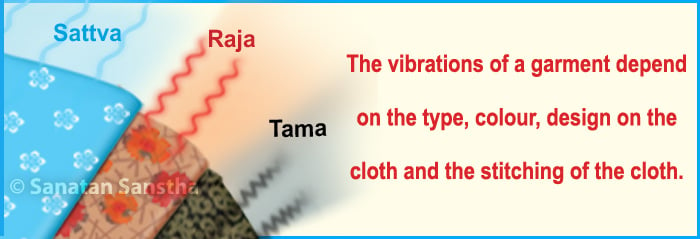
Clothes are an integral part of our lives. We wear dresses as per our liking and which we feel will help us build our personality and make us feel more confident. But we would have never thought about dressing up by considering the spiritual benefits or detriments. Wearing clothes as prescribed by Hindu Dharma not only helps us imbibe Divine Energies from the atmosphere, but also provides us protection against attacks by negative energies. Let us understand the science behind choosing the right kind of clothes through this article.
1. Importance of clothes from the physical perspective
Besides protecting the modesty, clothes protect the body from the cold, wind, sunshine and rain.
2. Importance of clothes from the psychological perspective
A. Clothes help recognize an individual’s temperament and personality
An individual selects clothes according to his temperament. People who always wear neat and ironed clothes are disciplined and conscientious. Those who wear casual clothes are frank and whimsical. Those who always wear untidy and weird clothes are lazy and careless. In short, clothes help identify the temperament and personality of an individual. Hence, it becomes necessary that an individual wear clothes complementary to a situation. For example, going for a job interview in neat and ironed clothes demonstrates the qualities of discipline and gentility.
B. Clothes affect the attitude of an individual
We experience a type of pleasant sensation upon wearing new clothes. On the other hand, if, for some reason, we are compelled to wear dirty and tight-fitting clothes, we are uncomfortable throughout. Many have experienced this. It only shows how clothes affect the attitude of an individual. Arthur Anderson (A company in England), carried out research on this aspect and, based on its results, brought about a change in the clothes of its employees. Following this change, the company employees started experiencing more job satisfaction and there was a vast increase in their output.
3. Importance of clothes from the spiritual perspective
A. Wearing clothes amounts to
taking the support of Maya to attain a level of Brahman-realized state
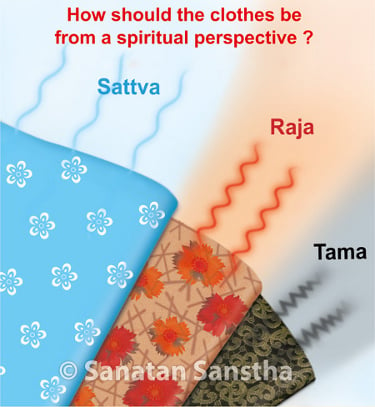
If being without clothes denotes renouncing attachment in the form of Maya (The Great Illusion) and attaining a level of Brahman (God in His aspect as the Creator of the universe)-realized state, then wearing clothes amounts to taking the support of Maya to be attractive and be able to attain a level of Brahman-realized state. – A Scholar (Through the medium of Mr. Nishad Deshmukh, 18th June 2007, 6.27 p.m.)
B. Clothes that are evidence of Dharmacharan
(Abiding by Dharma in daily life) prevent an individual from committing sins
Attire that includes dhoti , uparna (A shawl or a small single cloth worn loosely over the shoulders), gandh (Sandalwood paste), mala (Rosary) etc., which are evidence of Dharmacharan (Abiding by Dharma) for the external world, prevents an individual from committing sins, adharma (Unrighteous behaviour), unrestrained sex and consumption of alcohol. – Gurudev Dr. Kateswamiji
C. Wearing clothes attracts waves
from the atmosphere towards an individual
When an individual wears clothes, the friction caused by the subtle-contact of the garment with the body attracts waves from the atmosphere towards the individual which, aided by the clothes, enter the subtle-sheaths and the body of the individual.- A Scholar (Through the medium of Mr. Nishad Deshmukh, 18th June 2007, 6.27 p.m.)
D. Wearing clothes prescribed by Hindu Dharmaresults in the activation of
Shiva (Principle of Dissolution) and Shakti (Divine Energy) Principles through them
Clothes worn by men and women as prescribed in Hindu Dharma are designed by Deities and are those that manifest the Shiva and Shakti Principles. The clothes of women, meaning the sari (A traditional attire of Bharatiya women), awaken the Shakti Principle and the clothes of men activate the Shiva Principle. Wearing clothes as prescribed by the scriptures gives us the experience of our true identity. It also conserves our spiritual energy. Wearing clothes designed by the Deities automatically provides the energy necessary for the gross and the mental body. – An Unknown Energy (Through the medium of Ms. Ranjana Gawas, 12th December 2007, 11.30 a.m.)
E. Wearing clothes as prescribed by Hindu Dharma
attracts Chaitanya (Divine consciousness) and Principles of Deities
Two examples are given ahead.
1. Kurta and pyjama
Wearing a kurta and pyjama generates an elliptical (similar to the flame of a lamp) protective sheath around the body. This makes it easier for the individual to imbibe Chaitanya from the atmosphere and combat Raja -Tama components.
2. Sovale (A clean, washed, silk or cotton dhoti to be worn during puja [Ritualistic worship])
Sovale is more sattvik than kurta and pyjama. Wearing it generates a subtle spherical protective sheath around the body of the individual and simplifies imbibing of both, the marak -tarak (Destroyer-Saviour) and the Sagun -Nirgun (Materialized and Non-materialized) Principles of the Deities.
– A Scholar (Through the medium of Mrs. Anjali Gadgil, 17th June 2007, 8.59 p.m.)
F. Attraction and emission of sattvikta to and from the
clothes depends on the type of clothes and the way they are worn
Clothing and style of wearing them |
The capacity to
|
|---|---|
|
1. Nine-yard sari and dhoti |
Maximum |
|
2. Six-yard sari |
More Less |
|
3. Lungi |
Less |
|
4. Churidar ( A Bharatiya dress worn by women A. Dupatta over both the shoulders |
Less than six-yard sari
More |
– God (Through the medium of Ms. Madhura Bhosale, 28th November 2007, 7.15 p.m.)
From the above mentioned facts, we can understand the importance of traditional Hindu clothes such as the nine-yard sari and dhoti. This is one supreme example that shows how Hindu culture is full of Chaitanya.
G. Wearing sattvik clothes as advised by Hindu Dharma
during festivals and rituals helps imbibe maximum Chaitanya
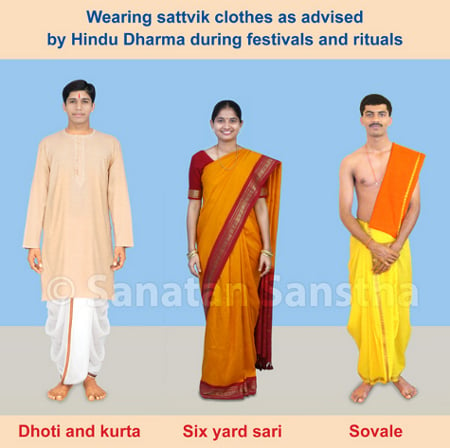
In Hindu Dharma, several Holy festivals, Religious festivals and Vowed religious observances are celebrated throughout the year. Besides, there are religious rituals that include ritualistic worship, thread ceremonies, marriages etc. On days such as Ramnavami (Birthday of Shriram according to the Hindu lunar almanac), Janmashtami (Birthday of Shrikrushna according to the Hindu lunar almanac), Hanuman Jayanti(Birthday of Deity Hanuman according to the Hindu lunar almanac), and Prakatdin (Day of public acclamation) of a Saint, the Principle of the respective Deities and Saints is predominantly active. During religious rituals, we invoke the Deities at the site of the ritual, and hence, they are present there. In short, the respective Chaitanya is active in a greater proportion on those days. Wearing sattvik clothes as advised by Hindu Dharma on these days allows us to benefit from that Chaitanya. For example, it is appropriate for women to wear a six-yard or a nine-yard sari with a border made of gold or silver thread work, and for men to wear a dhoti or kurta pyjama. – Mrs. Rajashree Khollam, Sanatan Ashram, Ramnathi, Goa
H. Benefits of wearing new or silk clothes and different
ornaments on the days of festivals, religious rituals and other auspicious days
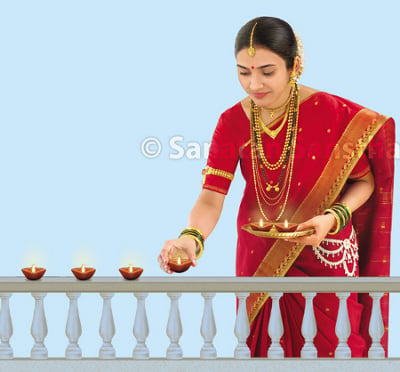
1. Receiving blessings from Deities
The Deities sometimes arrive on the earth in subtle form on auspicious days, on the days of festivals and on the days of religious rituals. To get adorned with ornaments and clothes on these days is akin to welcoming Their arrival. It pleases the Deities because of which They bless us, and we can imbibe Their waves.
2. Year-long benefit of the waves of Deities
Wearing new or silk clothes on the days of festivals attracts the Principles of Deities maximally towards these clothes and makes them sattvik. The waves of Deities attracted towards the clothes are retained for a longer period, and the one who wears them throughout the year benefits all year round.
3. The bodies getting purified by the waves of Deities’ Principles
As more and more waves of Deities’ Principles get attracted towards the gross body, the mental body, the causal body and the supracausal body of the individual, these bodies get purified and become sattvik. – God (Through the medium of Ms. Madhura Bhosale, 12th November 2007, 8.15 p.m.)
4. Wearing new or silk clothes and different ornaments on festivals or religious rituals and auspicious days provides protection from negative energies
During festivals, Yadnyas (Sacrificial fires), religious ceremonies such as the thread ceremony, weddings, vastushanti ceremony etc., a subtle-battle between the Deities and the negative energies takes place in the Universe, the atmosphere, and the premises, in that order. Therefore, people celebrating the festival and the ones who are present at the venue of the ceremonies can be affected by the subtle-battle and suffer from distress due to negative energies. By wearing gold ornaments and new or silk clothes, the sattvikta of the wearer increases with the formation of a protective sheath of Sagun-Nirgun level Chaitanya of God and the individual is protected from the attack of negative energies. – God (Through the medium of Ms. Madhura Bhosale, 12th November 2007, 8.15 p.m.)
I. Protection from the attack of negative energies because of clothes
1. Do not remain impure and naked; else you may suffer from negative energy distress.
शक्तिविषये न मुहूर्तमप्यप्रयतः स्यात् ।
नग्नो वा । – Apastambadharmasutra, 1.5.15.8-9
Meaning : If possible, do not remain impure or naked even for a moment.
2. To prevent distress due to negative energies, babies are kept wrapped in a cloth and not left naked. – God (Through the medium of Ms. Madhura Bhosale, 28th November 2007, 7.05 p.m.)
3. Wearing clothes as advised by Hindu Dharma provides protection from negative energies.
4. Flow of energy from the folds of a sari is towards the ground and it protects women from negative energies emanating from Patal (Hell region) :
Energy Principle emitted from the sari wages a battle with the negative energies present in the environment. It reduces the influence of negative energies on the mind and the body of the individual. A white blaze of light emitted from each fold of the sari appears like a sword. As the flow of energy from the folds of a sari is directed towards the ground, women are protected from the negative energies emanating from Patal. – An Unknown Energy (Through the medium of Ms. Ranjana Gawas, 9th June 2007, 11.00 a.m.)
4. Factors that determine the sattvikta of clothes, and their importance
A. Importance of everyday objects being Sattva-predominant
Every object has good or bad vibrations, depending on its inherent characteristics. Vibrations of various objects around us, and those that we use affect us continuously; hence, it is essential that these objects are Sattva -predominant. Compared with other objects, our clothes have the closest association with us.
B. Sattvikta of a garment depends on the
type of cloth, its colour, design on the cloth and its stitching
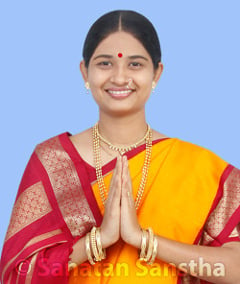
While selecting clothes from the perspective of sattvikta, a study of the science of vibrations proves spiritually more beneficial than merely the likes and dislikes of the individual. According to a principle in Spirituality, ‘Word, touch, form, taste, smell and their energy co-exist’. Accordingly, the vibrations of a garment depend on the type, colour, design on the cloth and the stitching of the cloth. If these factors are sattvik, then the garment imbibes sattvik vibrations and the individual wearing it gets the benefit of the sattvikta and Chaitanya.’ – Mrs. Janhavi Shinde, Sanatan’s seeker-artist, Sanatan Ashram, Ramnathi, Goa
Reference : Sanatan’s Holy Text ‘How should the clothes be from a spiritual perspective ?’

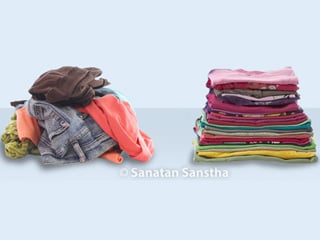 Comparison of different types of washed and unwashed, new and used clothes
Comparison of different types of washed and unwashed, new and used clothes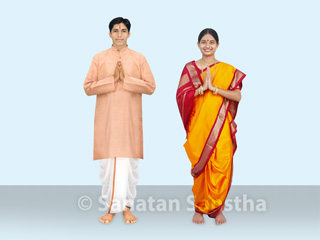 Effect of sattvik and inappropriate clothes on us
Effect of sattvik and inappropriate clothes on us Spiritual characteristics of various types of cloth
Spiritual characteristics of various types of cloth
This was really interesting to read, and has helped with a project relating to the meaning of festival clothing. Thank you for taking your time to explain 🙂
That was nice information… Though I got the head ache because of the rules, I thought to bring a slight change in my dressing